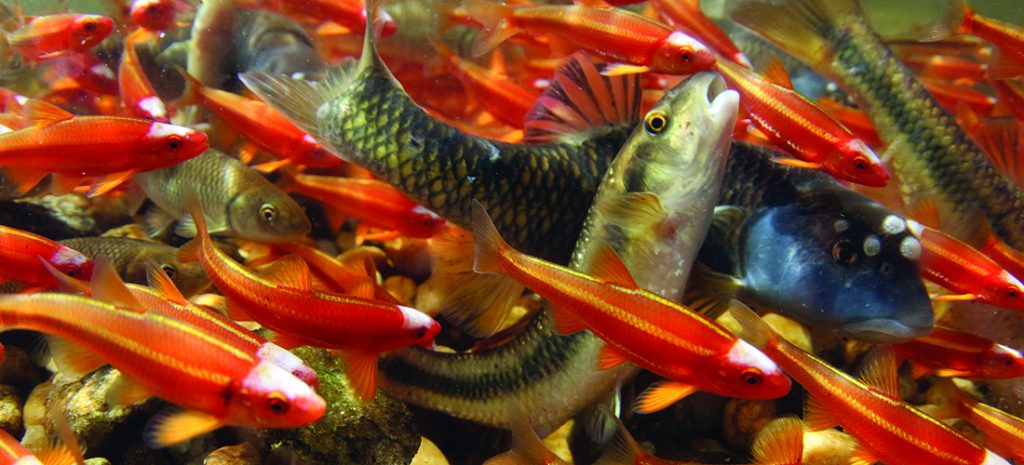
Documenting the lives of extraordinary fish in ordinary places
Story and Photographs by Todd Pusser
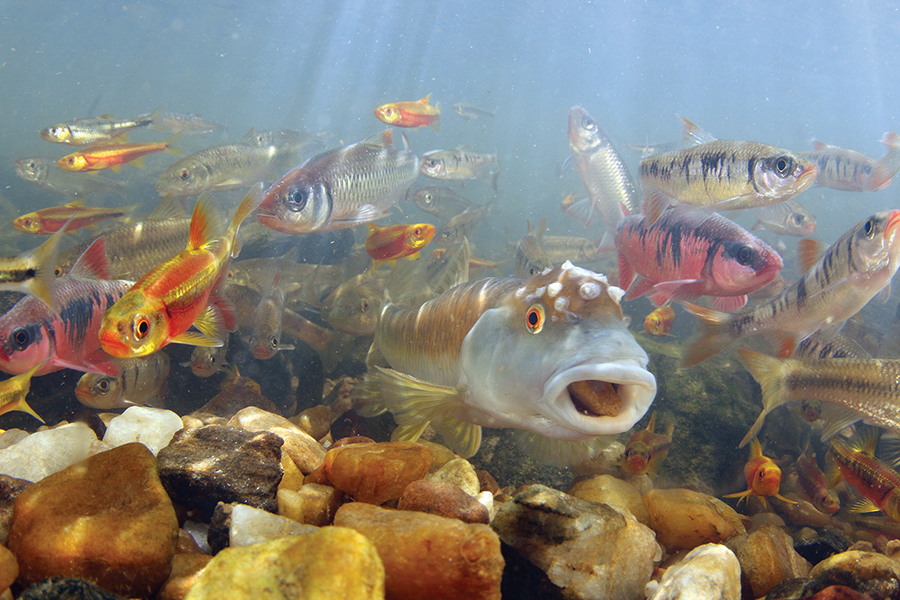
For over two hours I have been watching fish. Despite wearing a thick wetsuit, I am beginning to feel a bit chilled. Adjusting my face mask and stretching my legs in the swift current, I quietly exhale into my snorkel. One fish, just 7 inches long and sporting a pale blue head covered in distinctive white bumps, picks up a rock and drops it into its nest. Swarming around the blue-headed fish are hundreds of neon cherry-red fish, each the length of my index finger.
The kaleidoscope of colors flashing above the pyramid of rocks resembles a vibrant coral reef. However, as the cold water rushing down the back of my wetsuit reminds me, this is certainly not the tropics. Instead, I am lying face down in a knee-deep creek that flows through the foothills of North Carolina, near the town of Morganton, paying witness to an annual rite of spring.
Fumbling with the controls of my underwater camera, I suddenly feel that I am being watched. Lifting my head from the water, I see a fisherman standing just a few yards away. Through the condensation inside my face mask, I can see that he is wearing green waders and is holding a long fly rod in his right hand. He has a puzzled look on his face.
Removing the snorkel from my mouth, I mutter, “Hello.” There is an extended pause.
“Son, what are you doing?” the fisherman finally responds, with a distinct Appalachian drawl. It is obvious that the last thing he expected to see on this warm afternoon in his favorite creek was a man decked out in full scuba gear, like some lost Jacques Cousteau, holding a camera contraption that resembles something out of The War of the Worlds.
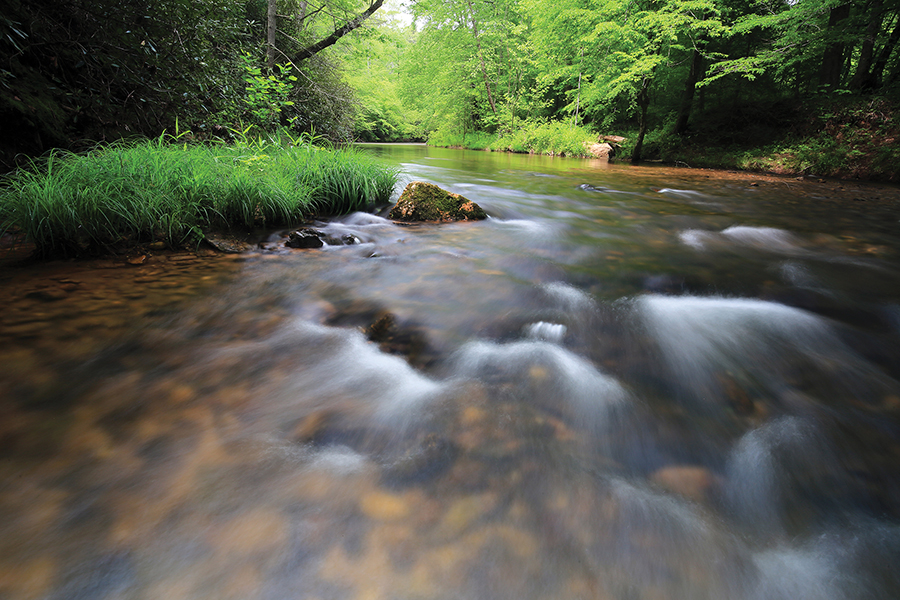
“I’m photographing fish,” I reply. Another pause.
“You taking pictures of trout?” he asks.
“No,” I respond. “I am taking photos of a bluehead chub.” Confused look once again.
“A what?” the fisherman asks.
I motion for him to step closer. “Right in front of me,” I say, pointing to spot in the shallow creek, “is a chub nest.”
Cautiously, the fisherman moves closer.
“Look for the large pile of rocks,” I say and motion again.
Staring intently through the reflections of trees and the blue sky on the surface of the water, I see the fisherman’s eyes widen with surprise.
“Oh, wow,” he exclaims. “Look at all those bright red minnows with white fins!” There’s that drawl again, pronouncing minnows as “minners.”
“Those are greenhead shiners,” I say, eager to impart a biology lesson. “They are all lit up in their breeding colors and are spawning in the chub nest. The rest of the year, those minnows are drab in color and are not nearly as bright as they are right now.”
The fisherman’s interest is thoroughly piqued.
Dragging myself up out of the water, I make a wide berth around the chub nest and approach the fisherman with my underwater camera housing in hand.
He asks, “What’s that fish you are taking pictures of again?”
I scroll through photos on the LCD of my camera, stopping at one in particular. “It’s called a bluehead chub,” I say, pointing to the photo of the blue-headed fish with white bumps on its head.
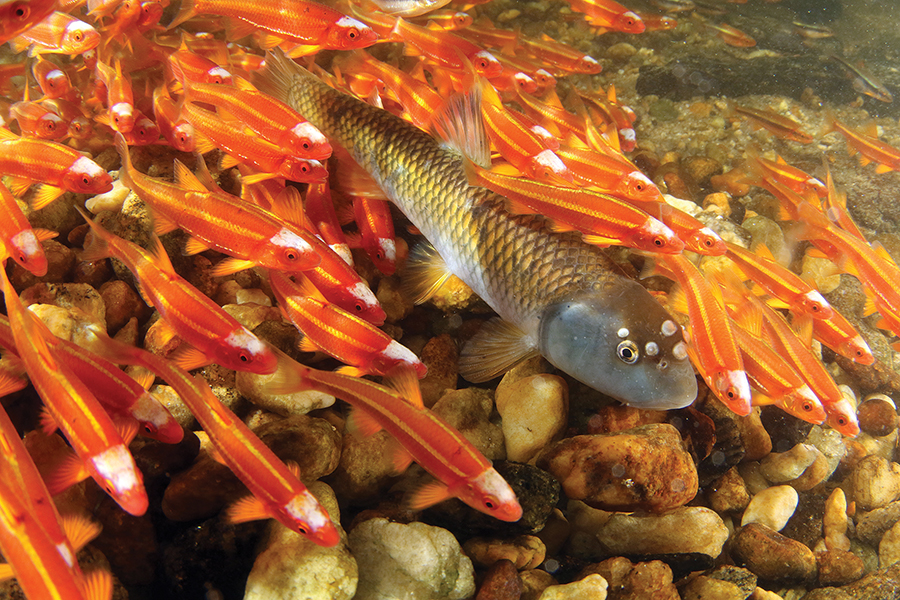
Recognizing the fish right away, the fisherman proclaims, “That’s a hornyhead. I catch them sometimes fishing for trout.” Hornyhead is an angler’s generic term for chubs within the genus Nocomis, of which seven species are found in North American waters. During the spring mating season, male chubs develop white bumps or tubercles on their heads, which they use to hit other males off their nests, somewhat like antlers in white-tailed deer.
“You say that’s a chub?” the fisherman asks. “And it builds a nest?”
“Yes, sir,” I answer. “The male chub will drop one rock at a time, building up a nest in just the right spot of the stream to attract a female. There may be hundreds of rocks in a nest. Those bright red minnows will school over the nest and drop their eggs in there as well.”
“Well, I’ll be,” says the fisherman. “I had no idea that was happening in this creek.”
This is a typical response I hear from people. These miniature “coral reefs,” full of bright colorful fish, which some biologists affectionately call “liquid sunshine,” are among the state’s most spectacular wildlife spectacles and are frequently overlooked.
“You from around here?” the fisherman asks.
“No. I’m from Virginia, but I grew up down in the Sandhills,” I said. “Each spring, I make a special trip out to the mountains just to photograph these fish.”
“That’s dedication,” the fisherman proclaims.
Indeed. It has become an obsession for me.
I did not elaborate, but for the past decade, I have traveled from West Virginia to Alabama trying to photograph the different species of chubs and the various brightly colored minnows that use their nests. Chubs are what biologists refer to as “keystone species.” They play vital roles in maintaining the overall health of any creek or stream in which they occur. An incredible 27 species of minnows have been documented using chub nests for reproduction.
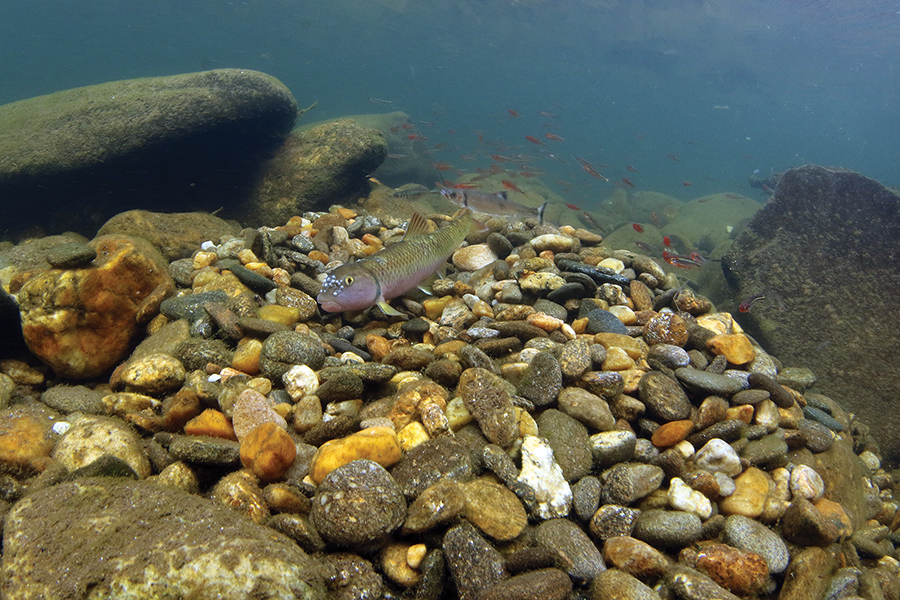
North Carolina is home to three species of Nocomis chubs. The bluehead chub is found throughout the Piedmont and foothills, in rivers that drain into the Atlantic Ocean. The river chub is a denizen of the mountains, swimming in streams that drain into the Tennessee River. The bigmouth chub is found only in the northwest portion of the state in the New River Drainage.
Each river drainage in the state possesses a different suite of colorful minnow species that spawn over chub nests and I have been trying to document them all. In the Dan River Drainage, north of Winston-Salem, I have photographed spectacular golden-black mountain redbelly dace and bright pink crescent shiners spawning over bluehead chub nests. I have sought out the endemic pinewoods shiners, whose rose-wine bodies, coupled with bright white heads, liven up the chub nests in the Tar and Neuse Rivers — the only places in the world where the species is found. In the Chatooga River, near Cashiers, I watched a northern water snake snatch a yellowfin shiner from a school of several hundred spawning over a chub nest. And just a few miles from my childhood home, I once photographed bright orange redlip shiners spawning over a bluehead chub nest, with equally colorful rosyside dace, in waters just 8 inches deep.
As we stood there in the creek, beneath a canopy of oak and tulip poplars, I could tell that the fisherman was eager to get back to it. Smiling, I say, “Good luck with the fishing.”
“Same to you,” he responds. With that, he lifts up his fly rod and continues walking downstream, disappearing around a bend.
I put on my face mask and snorkel and lie back down in the creek with camera in hand. The underwater fireworks show is still going off. It seems that even more greenhead shiners have joined in the fray. If ever there was a misnamed fish, surely it must be them, with their bright red bodies and milky white fins. I see nary a green head among them.
I notice the bluehead chub pick up yet another rock and drop it on top of the nest. I wonder how many times it has done that over the past few days. No doubt, hundreds of times. I chuckle to myself, thinking how my dad would appreciate its work ethic.
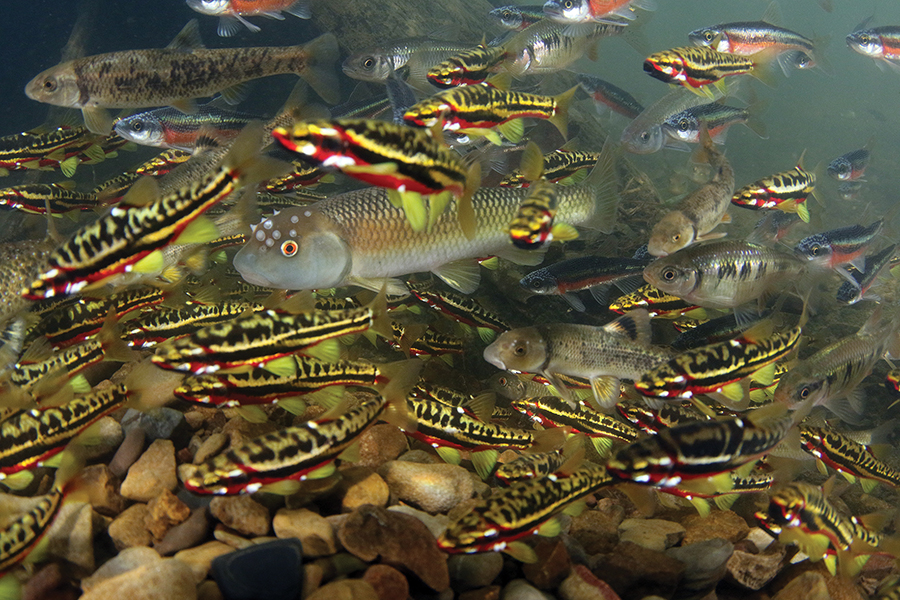
Suddenly, a female chub appears near the front of the nest, head facing into the current. Through a wall of neon red fish, I see the bright white bumps of the male’s head as he eases up beside her. In an instant, he arches his body in a semicircle around the female. Frantically beating tails from side to side, the pair release a cloud of sperm and eggs into the pile of rocks. It’s all over in a second. The female quickly darts off upstream and the male returns to guard duty, occasionally picking up rocks and dropping them back down. His constant mouthing of the rocks helps to aerate the precious eggs and prevents silt from accumulating on them. All the while, the greenhead shiners continue to swarm around the chub in dense waves of red.
Recently, biologists from Clemson University have shown that the greenhead shiner’s closest relative, the more appropriately named yellowfin shiner, will not spawn in the absence of a bluehead chub. The species relies entirely on the chub for successful reproduction. More surprisingly, their research has revealed that chubs may need shiners just as much as the shiners need the chubs. Their relationship is mutually beneficial.
As I continue to take photos, I begin to notice other species of fish swimming around the nest. A pair of central stonerollers, whose large lips hint to a lifestyle of scraping algae off rocks, skirt the rear edge of the rock pile, just behind the main swarm of greenhead shiners. Two dozen rosyside dace, with broad, contrasting black and red stripes running down their sides, swim above the shiners. Nearly 4 inches in length, they are considerably stockier than the greenheads. Rounding out the mix are a half dozen warpaint shiners, so named for their striking red, yellow and black facial markings.
The abundance in life in this one little spot of the creek is staggering.
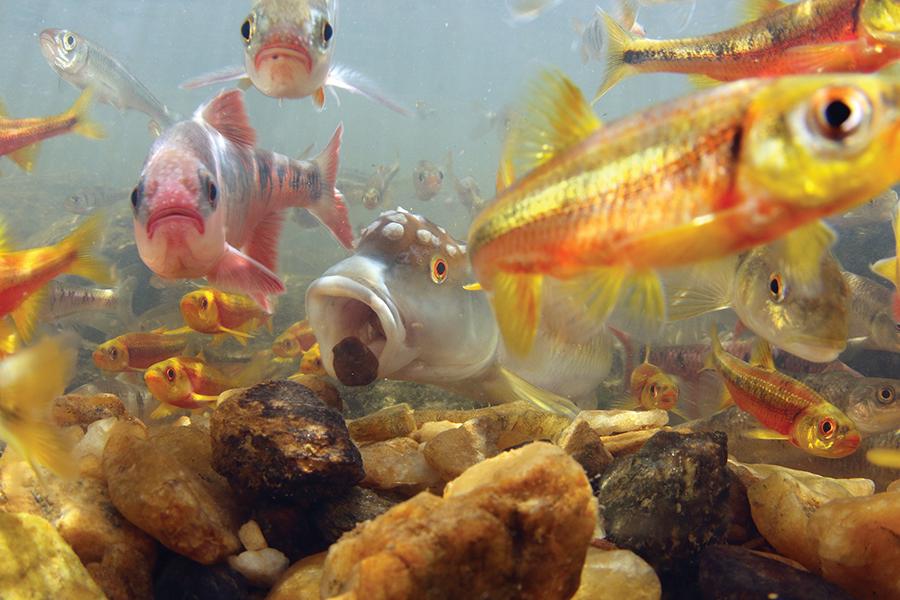
I lift my head from the water and see the fisherman returning from downstream. I fail to notice that another hour has passed by.
He has a large smile on his face and I see he’s had some luck. Now, along with his fly rod, he is carrying a stringer with two large rainbow trout in tow. As he approaches, he says, “Still at it, I see.”
“Yep,” I say taking the snorkel from my mouth. “The action has been pretty good.”
“Same,” he says. “And thanks for showing me such a cool sight.” He nods toward the chub nest.
“My pleasure. I always enjoy sharing.”
“By the way,” he casually remarks. “There’s an even larger chub nest downstream a couple hundred yards, just around that bend.” He motions toward the direction he just walked. “I would have never noticed it before. Must be 500 fish on it.”
“Really?” I say, perhaps overenthusiastically.
“Really,” he says walking slowly by. “Have a good day.”
“You too,” I smile. “Enjoy dinner,” I say, pointing to the trout.
The fisherman nods and continues walking upstream, eventually disappearing from sight.
Glancing at my watch, I see that there are still a few hours of daylight left. Perhaps that other nest will be worth checking out. Gathering up my camera gear, I slowly make my way downstream. PS
Naturalist and photographer Todd Pusser grew up in Eagle Springs. He works to document the extraordinary diversity of life both near and far. His images can be found at www.ToddPusser.com.
